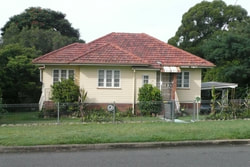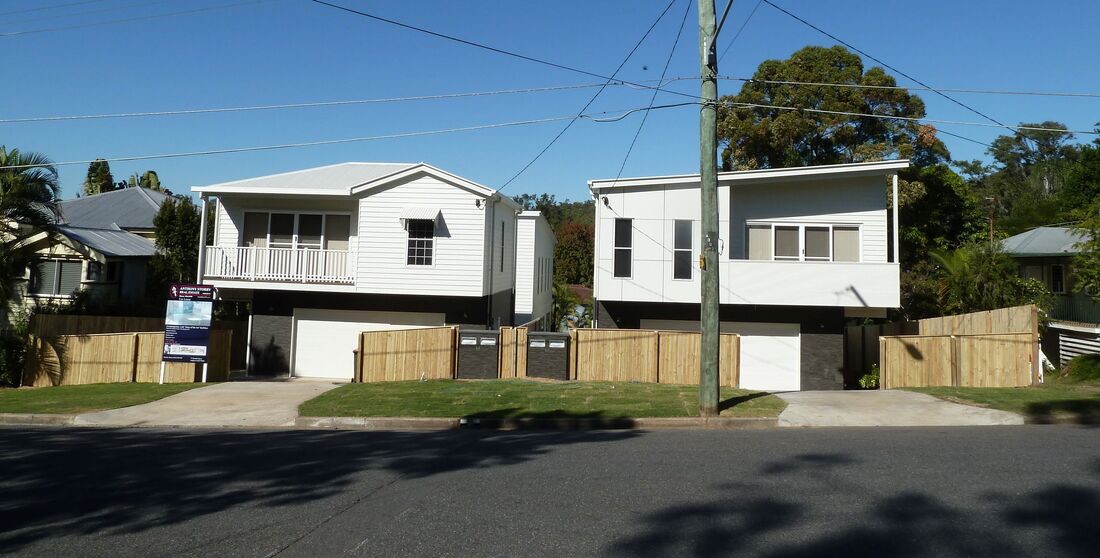ST. JOHN’S WOOD MEMORIES
Ray Paine School Days 1948-1957

12 & 14 Piddington St, prior to 2015
As small children we used slates to write on, and as we got older, we had ink wells built into our desks and a special pen, so that if you bent the nib on the pen, you could replace it with a new one. As we got older we used a fountain pen. The teachers always had a large black-board to write on, using chalk to write with and a duster to clean it.
The major sport we played was netball, cricket and hockey, with many children from Ashgrove State School representing Brisbane and Queensland in the 1950’s.
During lunch break, the boys would always be playing marbles in the dirt. At the school fete each year the boys would perform an exercise program, dressed in white shirts, shorts and socks. The girls would perform a dance routine, hanging onto ribbons from the top of the pole and dancing around the base of the maypole.
To get to school we would walk or ride our bikes. When we walked we would walk up to school in the morning and climb down the city council quarry face on the way home. We would get into trouble from our parents, because Mum could see us from the back verandah of our home at 12 Piddington Street. Thinking back, it was a dangerous climb.
If the boys were naughty in school, the teachers would hit you with a wooden ruler. We used to have a small bottle of milk each morning, after parade. This was usually warm by this time, as it had been left out in the sun, before being bought to class. In grade 7 & 8, the boys used to do wood work and metal work. The girls did sewing and cooking (this was done at the Ithaca State School). We would ride our bikes to Ithaca and back.
In the 1950’s, the picture show would open on Friday and Saturday nights only. They had canvas seats. It was located on the corner of Gresham Street and Royal
Parade.
Next door to the theatre (in Royal Parade) was a grocery shop and then there were 4 tennis courts. Next to the tennis courts was where the Cub and Scout huts were positioned. Then there was the park and the bamboo clumps. (No swings then). When playing tennis, if we miss hit any balls over the wire fencing, we would have to fish the tennis balls out of the creek. The tennis courts now have houses built on them.
Every year, because the bridge was much lower than it is today, the creek would flood over the bridge and we would be sent home from school for a day or two. We use to catch mullet, eels, catfish and rainbow fish (for our fish tanks). In the creek we also caught lobbies, which we take home and cook. We made home-made canoes from iron roofing, timber and tar. Then sail them down the creek. We built our bike tracks next to the creek. Many children got hurt. We also built out own trolleys and raced them down Piddington Street and around the corner and down Gresham Street to the bridge.
There was also another grocery store on the other side of the Woods in St. John’s Avenue.
The Granite House in Laird Street was visited by Royalty.
There was also a Girl Guide hut at the top of Piddington Street.
Some American soldiers stayed in St. John’s Wood during WW2.
On a quiet day, you could hear the city town hall clock chime.
Our milk was delivered early each morning in glass bottles with foil tops. During the year we would save all the tops and at Christmas time, the tops would be coloured with a Christmas design. We would string them together with string or cotton thread and use them as decorations. The bread was delivered each week day to our homes, warm and fresh from the baker’s truck. Many picnics were held down by the creek, or we would climb to the top of the mountain behind
the Woods, to have a picnic lunch.
St. John’s Wood was a great place to grow up in and the children I grew up with 50-60 years ago are still great friends of mine today.
The major sport we played was netball, cricket and hockey, with many children from Ashgrove State School representing Brisbane and Queensland in the 1950’s.
During lunch break, the boys would always be playing marbles in the dirt. At the school fete each year the boys would perform an exercise program, dressed in white shirts, shorts and socks. The girls would perform a dance routine, hanging onto ribbons from the top of the pole and dancing around the base of the maypole.
To get to school we would walk or ride our bikes. When we walked we would walk up to school in the morning and climb down the city council quarry face on the way home. We would get into trouble from our parents, because Mum could see us from the back verandah of our home at 12 Piddington Street. Thinking back, it was a dangerous climb.
If the boys were naughty in school, the teachers would hit you with a wooden ruler. We used to have a small bottle of milk each morning, after parade. This was usually warm by this time, as it had been left out in the sun, before being bought to class. In grade 7 & 8, the boys used to do wood work and metal work. The girls did sewing and cooking (this was done at the Ithaca State School). We would ride our bikes to Ithaca and back.
In the 1950’s, the picture show would open on Friday and Saturday nights only. They had canvas seats. It was located on the corner of Gresham Street and Royal
Parade.
Next door to the theatre (in Royal Parade) was a grocery shop and then there were 4 tennis courts. Next to the tennis courts was where the Cub and Scout huts were positioned. Then there was the park and the bamboo clumps. (No swings then). When playing tennis, if we miss hit any balls over the wire fencing, we would have to fish the tennis balls out of the creek. The tennis courts now have houses built on them.
Every year, because the bridge was much lower than it is today, the creek would flood over the bridge and we would be sent home from school for a day or two. We use to catch mullet, eels, catfish and rainbow fish (for our fish tanks). In the creek we also caught lobbies, which we take home and cook. We made home-made canoes from iron roofing, timber and tar. Then sail them down the creek. We built our bike tracks next to the creek. Many children got hurt. We also built out own trolleys and raced them down Piddington Street and around the corner and down Gresham Street to the bridge.
There was also another grocery store on the other side of the Woods in St. John’s Avenue.
The Granite House in Laird Street was visited by Royalty.
There was also a Girl Guide hut at the top of Piddington Street.
Some American soldiers stayed in St. John’s Wood during WW2.
On a quiet day, you could hear the city town hall clock chime.
Our milk was delivered early each morning in glass bottles with foil tops. During the year we would save all the tops and at Christmas time, the tops would be coloured with a Christmas design. We would string them together with string or cotton thread and use them as decorations. The bread was delivered each week day to our homes, warm and fresh from the baker’s truck. Many picnics were held down by the creek, or we would climb to the top of the mountain behind
the Woods, to have a picnic lunch.
St. John’s Wood was a great place to grow up in and the children I grew up with 50-60 years ago are still great friends of mine today.

